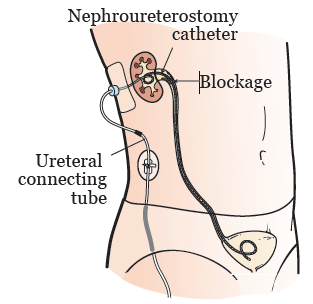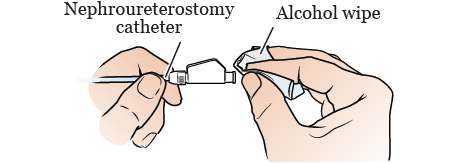This information explains how to do a capping trial on your nephroureterostomy (NEH-froh-YER-eh-ter-OS-toh-mee) catheter.
About capping trials
Your nephroureterostomy catheter goes from the outside of your body through your kidney, down your ureter, into your bladder. Your doctor may want you to do a capping trial on your nephroureterostomy catheter (see Figure 1). Capping your catheter helps your urine (pee) travel from your kidney down the catheter into your bladder. This is done to make sure the pathway between your kidney and your bladder is open.

Your nurse may cap your catheter for you while you’re in the hospital. You’ll need to do it yourself when you’re at home.
Before you cap your catheter, make sure your urine is clear yellow. You should not have any blood in your urine. If your urine is not clear yellow, call your healthcare provider’s office.
How to cap your nephroureterostomy catheter
-
Gather your supplies. You’ll need:
- An alcohol wipe
- A needleless connector
- A towel
- Put the towel under your workspace to keep the surface clean.
- Twist the connecting tube to disconnect the drainage tubing from your catheter (see Figure 2).

- Clean the end of your catheter with an alcohol wipe for 15 seconds (see Figure 3). Then let it dry fully.

- Connect the needleless connector to the end of your catheter by twisting it into place (see Figure 4).

Remember to change the needleless connector every 7 days, or sooner if it gets dirty.
What to do while your catheter is capped
If you have a capped nephroureterostomy catheter, watch out for these symptoms:
- Leaking around your catheter insertion site. The insertion site is where the catheter goes into your body.
- A temperature higher than 100.4 °F (38 °C) or chills.
- Pain, often above your hip, in your lower back, or around your catheter insertion site.
- You’re not able to urinate (pee) within 8 hours after you’ve capped your catheter.
These symptoms can happen any time after your catheter has been capped. If you have any of these symptoms, call Interventional Radiology to let us know.
Then, uncap your catheter. To do this:
- Take the needleless connector off your catheter.
- Clean your catheter with an alcohol wipe for 15 seconds. Then let it dry fully.
- Reconnect a new drainage bag to your catheter.
Do not recap your catheter without calling Interventional Radiology first.
Your symptoms should get better within 30 to 45 minutes. If they don’t, call Interventional Radiology for instructions on what to do next.
Contact information
If you have any questions or concerns, call your doctor in Interventional Radiology. You can reach them Monday through Friday, from to If it’s after , a weekend, or a holiday, call 212-639-2000. Ask to speak to the Interventional Radiology fellow on call.